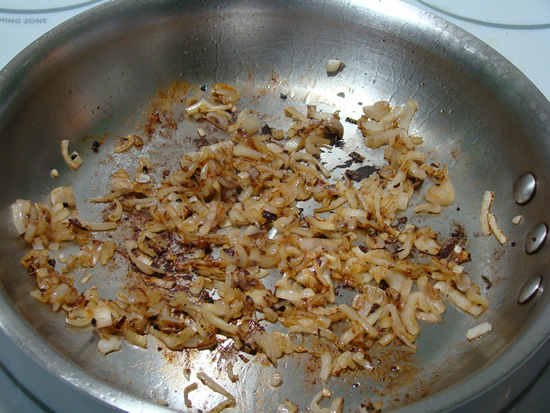There are 4 primary reasons why food sticks to cookware. When food sticks to cookware, it can damage the presentation of the dish, and make cleanup more difficult. Food sticking to cookware introduced a whole industry within the cookware market for nonstick cookware. However, regardless of the cookware materials you use, there are some simple steps to help avoid food sticking to cookware.
The 4 Reasons Why Food Sticks to Cookware
1) Cooking with heat set too high
In our microwave society where we can’t wait a full minute for water to boil, it is common for cooks to jack up the heat on a fry pan to medium high or high for everyday cooking. With the exception of high heat cooking like saute or browning, quality cookware manufacturers recommend low to medium heat for most cooking. When cookware is clad with aluminum or copper, those materials are such great conductors of heat that low to medium settings provide a heat level equivalent of medium to high on poorer quality cookware.
2) Placing frozen or very cold food into a hot pan
Once again, in a society where speed matters, we often toss frozen food right into a hot pan to get it cooking faster. That temperature differential will cause sticking. Quality cookware manufacturers recommend dethawing food or setting food out for 10 to 15 minutes so it can adjust to room temperature. Temperature differential is an important concept to understand. Cookware can warp if frozen foods are placed in a hot pan. If a hot pan is placed in a freezer for food storage is another cause of cookware warping. If you pay attention to temperature differentials, you can help avoid food sticking and cookware warping.
3) Poor quality cookware
No one wants to pay more than what they need to for cookware, nor throw out cookware before it needs to be. But let’s be honest. How many of you have at least one piece of non stick cookware that you know is beyond its time? Perhaps it lost its non stick qualities, or the non stick coating is scratched, chipped, or flaking off. If you have to add butter or oil to a non stick pan just like you would with a pan not coated with a non stick surface, there’s your sign it is time for it to go. When cookware has hot spots, that is a sign of genuinely poor quality cookware. Hot spots allow one part of the pan to get hotter than another part and the food sticks on those hot spots.
4) Improper cleaning methods
Yes, how you clean your cookware also affects the sticking properties of cookware. Stainless Steel Cookware manufacturers never recommend using rough or abrasive cleaning pads or chemicals. Doing so may scratch or damage the cooking surface. If the cooking surface gets scratched or nicked, those scratches or nicks can provide places where food can cling to and cause sticking. Nonstick cooking requires a properly cleaned and maintained cooking surface. Automatic dishwashers use very tough cleaning chemicals and high heat to clean dishes. That cleaning environment is very tough on shiny cookware exteriors and smooth interior surfaces. Most anodized aluminum cookware warranties are voided if the cookware is placed in an automatic dishwasher. Non-enameled cast iron cookware needs to be cleaned with just hot water and a cast iron cleaning brush. Using soap will remove the natural non stick coating that builds with use. Be sure to check your cookware care and use instructions.
When Food Sticking is Needed
Chefs know there are times when you want food to stick. Nothing beats a great sauce that was prepared with food particles stuck, deglazed, or caramelized on a pan. After searing some beef, chicken, pork, or lamb in a pan and having those leftovers stuck in the pan can be the beginning of a great sauce. Saute pans are made for the purpose of higher heat cooking where vegetables and meats cook fairly rapidly and the remains in the pan can be used for glazes or sauces.
Using the Same Cookware for a Nonstick and a Sticking Surface
 So how can the same cookware provide a nonstick surface when you don’t want it to stick, yet stick when you want it to stick? Easy. The answer is to learn the proper cooking techniques for the cookware material you are using. Most nonstick surface manufacturers do not recommend high heat. If you need to sear or brown a food, use cast iron, anodized aluminum, or stainless steel. Those same surfaces can be used both for sticking and nonsticking when the proper heat is used, and the cookware is cleaned according to manufacturer specifications.
So how can the same cookware provide a nonstick surface when you don’t want it to stick, yet stick when you want it to stick? Easy. The answer is to learn the proper cooking techniques for the cookware material you are using. Most nonstick surface manufacturers do not recommend high heat. If you need to sear or brown a food, use cast iron, anodized aluminum, or stainless steel. Those same surfaces can be used both for sticking and nonsticking when the proper heat is used, and the cookware is cleaned according to manufacturer specifications.
No one likes it when food stick to cookware when it is not intended. When you know why food sticks, you can take measures to prevent it. Know that too high of a heat, temperature differential, poor quality cookware, and cleaning methods are all known causes of why food sticks to cookware. I hope this information helps you to understand the nature of cookware and how its proper use can make your cookware last longer.
Happy Cooking!

